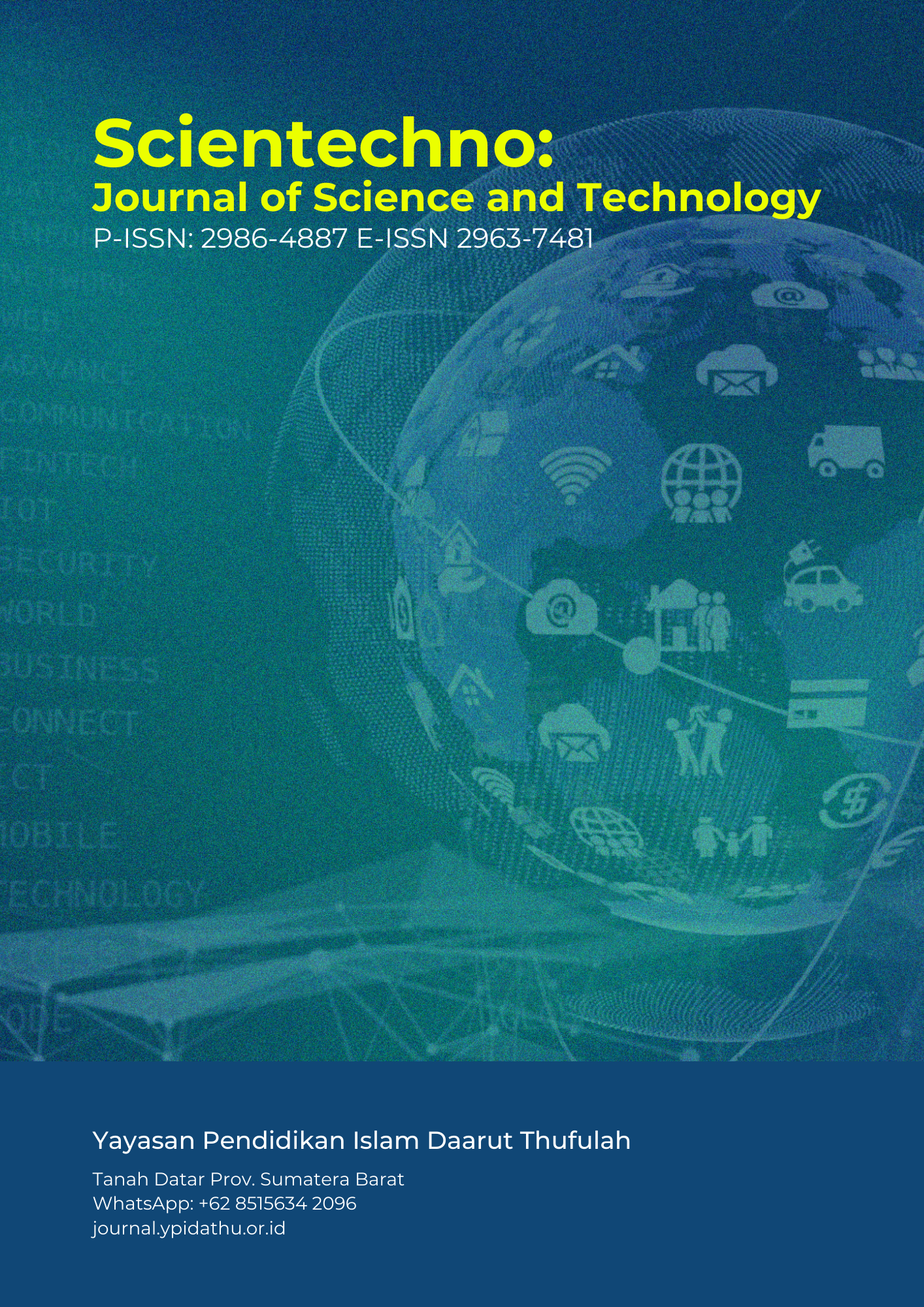The Analysis of the Effect of Adding Glass Powder Waste as a Cement Substitution and the Use of Pumice Aggregate on the Compressive Strength of Light Concrete
Abstract
Along with the increasing need for building materials and high cement prices, innovation in the use of alternative materials that are environmentally friendly and economical is needed. Glass powder waste, which is difficult to decompose and has the potential to pollute the environment, has the potential as a cement substitute because of its supportive physical and chemical properties. Additionally, pumice, as a lightweight aggregate, can reduce the dead load of the structure and enhance the efficiency of construction execution. This study aims to analyze the effect of the addition of glass powder waste as a cement substitution and the use of pumice aggregate on the compressive strength of light concrete. Glass waste, which comes from industrial and household waste, is used as a cement substitute with variations of 0%, 5%, 10%, and 15%. In contrast, pumice is used as a partial substitute for coarse aggregate. The method used is experimental, with laboratory testing including compressive strength tests at 14 and 28 days of age. The results showed that the addition of glass powder at a percentage of 5% gave the highest compressive strength values of 10.98 MPa (14 days) and 12.40 MPa (28 days), compared to concrete without glass powder, which only reached 8.14 MPa (14 days) and 11.11 MPa (28 days). This suggests that the combination of glass powder and pumice stone can significantly increase the compressive strength of light concrete, although the efficiency of the mixture decreases at higher percentages. This research provides an alternative to the use of local waste and aggregates in the development of environmentally friendly and economically efficient concrete.
Full text article
References
Valencia, L., Silva, G., & Torres, J. (2023). Green concrete with glass powder-A literature review. Sustainability, 15(20), 14864. https://doi.org/10.3390/su152014864
Zhao, X., Zhang, Y., & Li, W. (2022). The efficiency of recycled glass powder in mitigating the alkali silica reaction induced by recycled glass aggregate in cementitious mortars. Materials and Structures, 55(2), 127. https://doi.org/10.1617/s11527-022-01989-7
Mohseni, E., Bahiraei, S., & Hosseini, S. A. (2019). Effect of new mixing method of glass powder as cement replacement on mechanical behavior of concrete. Construction and Building Materials, 205, 136–144. https://doi.org/10.1016/j.conbuildmat.2019.01.207
Sharma, S., & Sharma, A. (2021). Study on effects of pumice in high performance lightweight concrete by replacing coarse aggregates. IOP Conference Series: Earth and Environmental Science, 822, 012012. https://doi.org/10.1088/1755-1315/822/1/012012
Aydin, S., & Celik, F. (2023). Use of pumice aggregate in cementitious rheoplastic lightweight concrete. Journal of Sustainable Construction Materials and Technologies, 8(1), 56–65. https://doi.org/10.29187/jscmt.1214086
Alavi, M., Jamei, M., & Pour, A. R. (2023). Experimental investigation of durability properties of polymer-coated pumice aggregate lightweight concretes. Polymers, 15(2), 253. https://doi.org/10.3390/polym15020253
Tanriverdi, M., & Turgut, P. (2022). Durability improvement of pumice lightweight aggregate concrete by incorporating modified rubber powder with sodium silicate. Materials, 15(4), 786. https://doi.org/10.3390/ma15040786
Pradana, A. A., & Santoso, H. (2024). Sustainable utilization of waste pumice powder in slag-based geopolymer concretes: Fresh and mechanical properties. Sustainability, 16(21), 9296. https://doi.org/10.3390/su16219296
Siregar, R., & Halomoan, L. (2023). Compressive strength of concrete containing recycled glass powder. President University Civil Engineering Journal, 6(2), 74–82. https://e-journal.president.ac.id/index.php/PCEJ/article/view/4242
Adila, A. (2023). The effect of pumice stone as a substitute for coarse aggregate and silica fume additives on the compressive strength and tensile strength of concrete [Thesis, Islamic University of Indonesia, Faculty of Civil Engineering and Planning, Bachelor of Civil Engineering Study Program].
Manoj, S., & Lakshmi, T. S. (2024). Experimental study on compressive strength of concrete using pumice aggregate with GGBS and metakaolin. AIP Conference Proceedings, 3193. https://doi.org/10.1063/5.0233218 Astrophysics Data System
Sridharrajagopal, S., & Hosadurga, A. (2021). Study on effects of pumice in high performance lightweight concrete by replacing coarse aggregates. IOP Conference Series: Earth and Environmental Science, 822, 012012. https://doi.org/10.1088/1755-1315/822/1/012012 IOPscience
Zhang, Y., & Kavinkumar, P. (2024). Performance of lightweight concrete with different aggregates—a comprehensive review. Discover Civil Engineering, (2024). https://doi.org/10.1007/s44290-024-00015-9 SpringerLink
Hattab, M., & Saidi, H. (2024). Characterisation of reactive supplementary cementitious materials and recycled glass: XRD and Raman spectroscopy contributions. arXiv preprint arXiv:2404.01899. https://doi.org/10.48550/arXiv.2404.01899 tandfonline.com
Patel, P., Wang, J., & Olofinnade, O. (2022). Strength development and microstructural mechanism of waste glass powder in cement mortar. Journal of Building Engineering, 45, 103363. https://doi.org/10.1016/j.jobe.2022.103363 reddit.com+2tandfonline.com+2en.wikipedia.org+2
Hegazy, A., & Morsi, E. (2022). The mechanical properties of lightweight volcanic pumice concrete exposed to high temperatures. Journal of Materials in Civil Engineering, 34(5), 01022015. https://doi.org/10.1061/(ASCE)MT.1943-5533.0003739 degruyter.com
Alavi, M., Jamei, M., & Pour, A. R. (2023). Durability investigation of polymer-coated pumice aggregate lightweight concretes. Polymers, 15(2), 253. https://doi.org/10.3390/polym15020253 mdpi.com
Tanriverdi, M., & Turgut, P. (2022). Improving durability of pumice aggregate concrete by adding rubber powder and sodium silicate. Materials, 15(4), 786. https://doi.org/10.3390/ma15040786 mdpi.com
Pradana, A. A., & Santoso, H. (2024). Utilizing waste pumice powder in slag-based geopolymer concretes: fresh and mechanical properties. Sustainability, 16(21), 9296. https://doi.org/10.3390/su16219296 mdpi.com
Nugraha, B. P., Sudjatmiko, E. T., & Bali, I. (2023). Compressive strength of concrete containing recycled glass powder. President University Civil Engineering Journal, 6(2), 74–82. https://doi.org/10.30597/PCEJ.v6i2.4242 e-journal.president.ac.id
SNI. (1990). SNI 03-1974-1990:. Concrete Compressive Strength Testing Method. Jakarta.
SNI. (2002). SNI 03-3449-2002:. Procedure for making a Plan for Mixing Light Concrete with Light Aggregate. Jakarta.
SNI. (2008). SNI 03-3402-2002:. Structural Light Concrete Fill Weight Testing Method. Jakarta.
Authors
Copyright (c) 2025 Galing Wira Buana, Nuni Khoirinnisa Hudaya Taher, Tira Roesdiana

This work is licensed under a Creative Commons Attribution-ShareAlike 4.0 International License.





